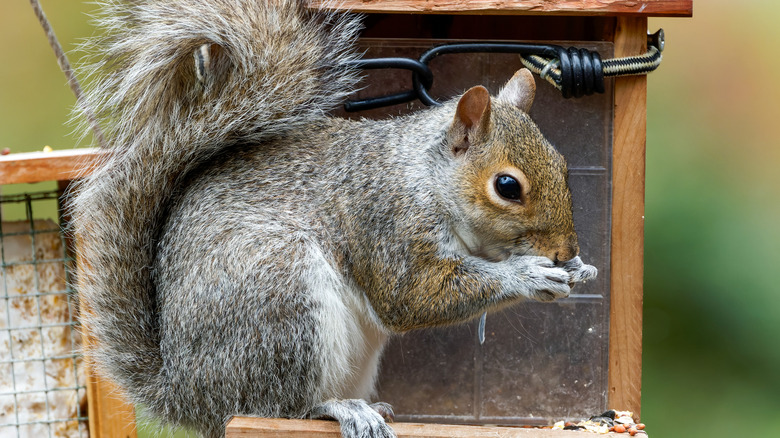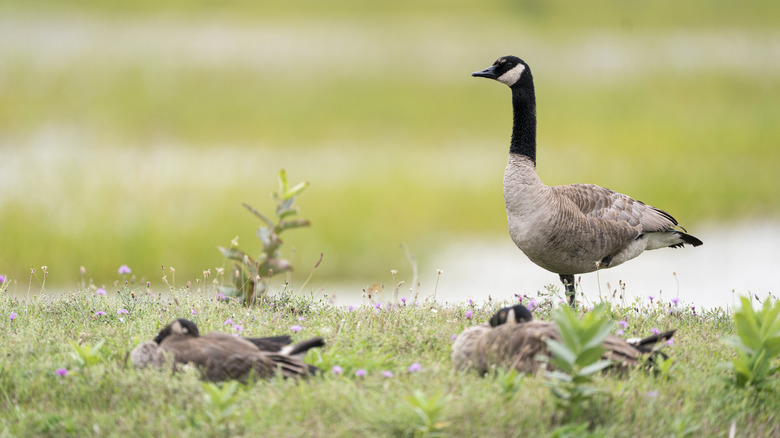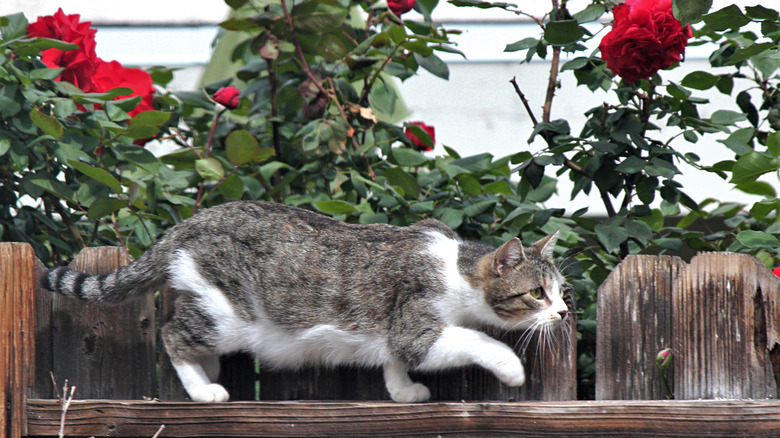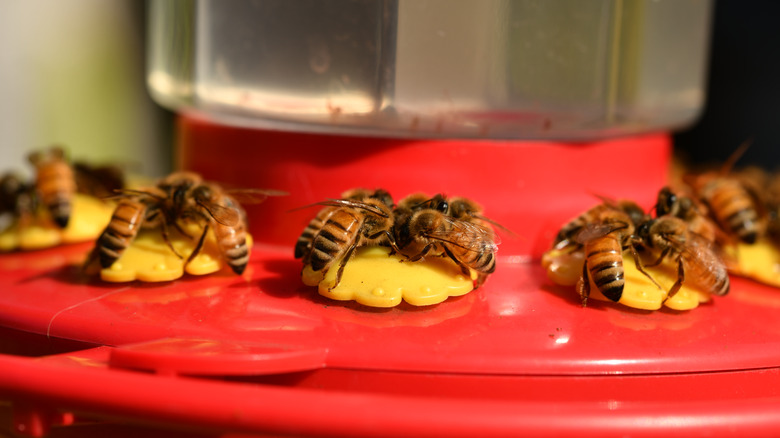We may receive a commission on purchases made from links.
Watching the birds that come to the feeders in your yard during the cold winter months is a simple joy of life at home. But this pleasurable pursuit becomes a problem when unwelcome wildlife, rodents, and insects try to take over. Although you do want to feed a variety of avian friends, you’ll want to take preventive steps to discourage the pesky critters that can spoil the fun.
Depending on where you live, your bird feeders might attract squirrels, raccoons, rats, or even bears. You can install baffles on poles and position your bird feeders in open areas to deter wildlife. Additionally, you might opt for bird feeders that feature exterior cages or weight-activated perches to prevent the bandits from accessing the food. If you like to feed hummingbirds in the summer, you can minimize the invasion of ants and bees by selecting feeders with ant moats and bee guards. Read on to explore these solutions and more best practices that allow you to feed the birds without inviting unwanted guests to the feast.
Outsmart those acrobatic squirrels to keep them off your bird feeders

When you’re feeding birds in the yard, it’s inevitable that the squirrels will want to get in on the action. These persistent little creatures enjoy the taste of most birdseed, and they’ll perform gymnastic feats to access it. While they can’t fly, squirrels can leap up to 10 feet to land on a feeder and steal the birds’ dinner.
You can outsmart the squirrels by positioning your feeder in an open space. It should be at least 10 feet from jumping-off points like the roof of your house, the top of a fence, or any tree branches. Place the bird feeder atop a pole at least 5-to-6 feet tall and attach a dome-shaped baffle like this one to the top, above the feeder. Then, install an inverted cone-shaped baffle below the feeder to limit the squirrels’ access by climbing up the pole from the ground. Check out this option from Amazon. Alternatively, you can hang the bird feeder from a taut wire attached to two sturdy trees. Then, string empty plastic bottles, old CDs, or pieces of PVC pipe along the wire to prevent the tightrope-walking critters from reaching the feeder. As a further deterrent, sprinkle cayenne pepper on the bird seed. The birds will not detect it, and they’ll eat the seed as usual. But the squirrels will be repelled by the spicy smell and taste.
Repel the clever and dexterous raccoons from the birds’ feeding stations
Although raccoons do not have opposable thumbs like humans, their five long fingers on each foot exhibit remarkable dexterity, making them masterful invaders of bird feeders. It’s never a good idea to feed raccoons, as they may carry diseases such as rabies, canine distemper, and roundworm. If you notice raccoons coming to your bird feeders, take immediate steps to repel them.
Place your feeders on poles in open areas and install conical baffles like this one from Amazon to deter them from climbing. Each baffle should be made of steel, at least 10 inches in diameter, and 2 feet tall. As an alternative, you can outsmart the raccoons by hanging a bird feeder from a shepherd’s-hook type of pole that is no more than ½-inch in diameter. They won’t be able to get a good climbing grip on such a thin pole. Be sure to secure the shepherd’s hook so that the raccoons can’t knock it over. Similarly, bird feeders suspended from horizontal wires with empty plastic bottles strung along them may be immune to invasion by raccoons.
Raccoons are primarily active at night, so they’ll lose interest if you bring the bird feeders indoors at dusk each evening. Alternatively, you can fill the feeders with only enough seed to keep the birds happy during the day, using feeders that catch the falling seed to keep it off the ground. Consequently, there won’t be enough seed in the feeders or on the ground to attract the nocturnal bandits.
Prevent rats and mice from feasting in your bird feeders
Ernie Cooper/Shutterstock
Rats love to feast on bird seed, and they’re attracted to the feeders. But if you see rodents in or around your home, you never want to encourage them. According to the U.S. Environmental Protection Agency, they spread diseases and cause damage, making them distinctively unwanted guests. If you have an infestation of rats or mice, it’s imperative that you halt your outdoor bird-feeding activities while you’re trying to control the situation by poisoning or trapping the critters.
To deter rats and mice, place bird feeders on poles at least 4 feet off the ground and 8 feet away from tree branches, fences, or other jumping-off points. Install baffles on the poles to prevent rodents from climbing upward from the ground. Keep in mind that the critters are less likely to climb metal poles than wooden ones. To avoid attracting rats, store bird seed in tightly closed containers made of metal or glass. Clean up any bird seed that drops on the ground, and don’t leave seed in the feeders overnight. Finally, you can discourage rats by sprinkling cayenne pepper on the bird seed. The birds can’t smell or taste it, but the rodents will be repelled. Similarly, rats hate the smell of peppermint as well as fragrant herbs. Spray peppermint oil, citronella oil, or castor oil around your garden to repel rats from the area.
Deter the large birds that bully the smaller ones as they try to feed
Andi111/Shutterstock
You probably enjoy watching the birds that come to your feeders, and you have favorite species that partake of the seed and suet you offer to them. But some types of birds are simply bullies. They consume more than their share of the food due to their voracious appetites, and they may scare off the smaller birds with their large size and aggressive behavior. In the line-up of bully birds, you’ll find bluejays, grackles, blackbirds, European starlings, house sparrows, pigeons, and crows.
You can thwart the efforts of large bully birds by using feeders with cages built around them, like this option from Amazon. These feeders allow small birds in but keep the larger ones out. Similarly, some feeders have a weight-activated perch that triggers a mechanism to close off the feeding area when a heavier bird (or a squirrel) lands on it. Here’s an example from Amazon. Alternatively, you can use a feeder with very short perches, allowing the small birds to feed but preventing larger ones from finding a secure landing place. If you have ground-feeding bullies like pigeons, you can discourage them by keeping the area around your feeder cleared of fallen bird seed at all times.
Avoid attracting bears to your bird feeders
Robert Winkler/Getty Images
In bear country, a bird feeder is an open invitation to especially unwelcome guests. You should never feed bears, either on purpose or by accident. According to the Maine Department of Fisheries and Wildlife, it’s important to remove bird feeders from your yard from April 1 through November 1, the period of time when bears are active. (Adjust these dates if you live in a warmer, southern climate). Bears are capable of tearing down bird feeders that are mounted high off the ground, atop sturdy poles. When they can find food in residential yards, the bears begin to lose their fear of people and spend more time in neighborhoods.
Instead of putting out bird feeders with commercially available seeds and suet, you can take other steps to ensure that feathered friends are welcome in your yard. Install a bird bath or a water feature and plant small, branching trees that offer numerous places to perch along with foliage in which to hide. You can provide living spaces for birds by mounting nesting boxes (like this one from Amazon) on poles in your yard. Finally, plant a variety of native plants that produce seeds and berries to feed the birds naturally. Take these steps to provide food sources and a healthy habitat for birds without attracting bears.
Prevent an invasion of wild geese at the feeders intended for smaller birds

Doug4537/Getty Images
In some localities, the flocks of resident, wild geese might seem more like an invasion. In the past 100 years, their numbers have increased substantially, creating problems in urban and suburban areas. The practice of feeding geese has caused the problems to get worse. Wild geese can destroy crops, gardens, and lawns. On top of that, they may become aggressive to pets and humans. Especially if you live on a pond or lake, the geese may be attracted to your yard. To make it unattractive to these avian invaders, you can plant a strip of land at the water’s edge with dense, tall grasses, shrubbery, ivy, and cattails. This will create a barrier that the geese do not like, and they might go off looking for another home.
The best way to deter wild geese that come to your backyard bird feeders is to simply discontinue feeding the birds for a period of time. Clean out the feeders, and be sure to clean up any seed that may have dropped on the ground. When they no longer find food, the geese will lose interest in your yard and move on to a different location.
Put a stop to free-roaming cats that stalk birds at the feeders

Lilly P. Green/Shutterstock
You’re trying to attract a variety of birds to your yard by offering seed, suet, and other foods in well-maintained bird feeders. Obviously, you don’t want to create a dangerous situation by allowing outdoor cats to stalk the birds. You can manage your own domestic cats by keeping them indoors when the birds are feeding. But feral cats and neighborhood wanderers might show up, and they’re capable of leaping high off the ground to catch birds.
If stray cats are a problem for the birds you’re trying to attract, The Humane Society of the United States suggests a motion-activated, ultrasonic cat deterrent such as this one from Amazon. It emits a high-pitched sound that humans cannot hear, but it scares away the cats. As an alternative, you might introduce organic materials that repel cats due to their fragrances. Scatter fresh orange or lemon peels on the ground near your bird feeders. Or, spray the area with citrus, vinegar, eucalyptus, lemongrass, or citronella sprays. Plant the herbs rue or rosemary in the soil under a bird feeder, and cats will avoid the area. As an additional deterrent, you can place a plastic carpet runner on the ground beneath your bird feeder. Turn it over so that the little plastic spikes are on the top side, and the cats will avoid walking in the area.
Prevent an infestation of ants, cockroaches and other insects in your bird feeders

Christopher Landis/Shutterstock
Cockroaches are attracted to the seed droppings from bird feeders. The sugar water in hummingbird feeders lures ants, wasps, and bees. For these reasons, it’s best to avoid window-mounted bird feeders. While it’s nice to watch the birds at close range, the window feeders present an open invitation for pesky insects to infest your home.
To avoid attracting cockroaches, make a habit of cleaning your bird feeders and the area around them regularly. Put out only enough seed to feed the birds for a day, and remove any remaining seed each evening. Be sure to clear the ground below the feeders of husks and droppings. When you feed hummingbirds, use a feeder with a built-in ant moat and bee guards, like this one from Amazon. You’ll want to avoid dripping the sugar water on any surfaces below the feeder, as the dripped nectar attracts wasps, ants, and bees. Keep the ant moat filled with water to drown the ants as they try to access the hummingbirds’ food. To further deter ants, you can use thin fishing line to hang your hummingbird feeder. They cannot walk on it as easily as they can climb a pole. When you’re shopping for a hummingbird feeder, avoid the color yellow. The Division of Agriculture Research and Extension at the University of Arkansas advises against selecting a feeder with yellow parts because the color attracts bees.


